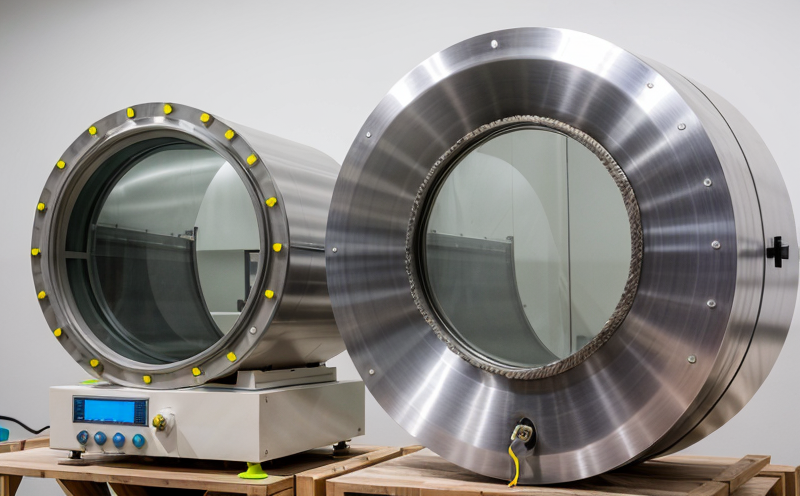ASTM C1837 Long-Term Durability of Radiation Shielding Materials
The ASTM C1837-19 standard test method is a critical tool in ensuring the long-term durability and reliability of radiation shielding materials used in various industries, including nuclear power plants, medical facilities, and defense sectors. This test evaluates how well these materials withstand environmental factors such as gamma ray exposure over extended periods.
Developed by ASTM International (ASTM), this standard is widely recognized for its rigorous methodology which simulates the real-world conditions under which radiation shielding materials will be used. The test involves exposing samples of the material to high-intensity gamma rays, typically using a Cobalt-60 source, and then evaluating changes in properties like density, thickness, and other relevant characteristics over time.
Understanding the long-term behavior of these materials is essential for ensuring safety and compliance with regulatory standards. For instance, nuclear power plants require materials that can maintain their integrity and effectiveness for decades without degradation. In medical applications, especially for proton therapy facilities, precise control over radiation exposure ensures accurate treatment delivery while minimizing side effects.
The ASTM C1837 test procedure is designed to mimic the expected operational conditions as closely as possible. This includes not only gamma ray exposure but also considerations like temperature fluctuations and humidity levels that may affect material performance. By subjecting samples to these simulated environments, researchers can predict how well materials will perform in actual use.
One of the key aspects of ASTM C1837 is its focus on long-term durability. Unlike shorter-duration tests that might provide immediate insights into a material's stability, this test aims to reveal potential issues that could arise over extended periods. This is crucial for industries where safety and reliability are paramount.
Another important feature of the ASTM C1837 standard is its emphasis on reproducibility. The test method provides detailed instructions to ensure consistent results across different laboratories. This consistency allows researchers, manufacturers, and regulatory bodies to compare data accurately, contributing to a more robust industry-wide understanding of material performance.
The results from the ASTM C1837 test are critical for several reasons. They help manufacturers optimize their product designs by identifying potential weaknesses early in the development process. For quality managers and compliance officers, these tests provide assurance that materials meet stringent regulatory requirements. R&D engineers can use this information to refine their materials further based on real-world performance data.
In summary, ASTM C1837 is a cornerstone of ensuring the long-term reliability of radiation shielding materials. Its rigorous testing process helps protect public health and safety by identifying any potential weaknesses in these critical materials before they are deployed in high-risk environments.
Why It Matters
The importance of ASTM C1837 cannot be overstated, particularly for industries reliant on radiation shielding technology. The test ensures that materials used in sensitive applications remain effective and safe over extended periods. This is especially crucial given the long lifecycle of many nuclear facilities and the critical nature of medical treatments involving radiation.
For nuclear power plants, reliable radiation shielding is essential to prevent accidental releases of harmful radiation into the environment. Failures in these systems could lead to severe environmental damage and potentially life-threatening situations for nearby populations. By adhering to ASTM C1837 standards, facilities can ensure that their materials are robust enough to withstand continuous exposure to high-intensity gamma rays without degradation.
In the medical sector, particularly proton therapy centers, accurate radiation shielding is vital for delivering precise treatments with minimal side effects. Any reduction in material effectiveness could lead to treatment inaccuracies or increased risk of complications for patients. ASTM C1837 helps ensure that materials used in these facilities maintain their integrity and precision over time.
Moreover, the test method supports broader industry standards by providing a consistent framework for evaluating radiation shielding materials. This consistency is crucial for regulatory bodies to enforce safety guidelines across various applications. Compliance with ASTM C1837 ensures that manufacturers and operators are meeting international standards, thereby enhancing overall confidence in the industry.
Overall, the implementation of ASTM C1837 contributes significantly to public safety, environmental protection, and the reliability of radiation shielding materials used in critical industries.
Customer Impact and Satisfaction
- Enhanced Safety: ASTM C1837 ensures that radiation shielding materials are reliable over extended periods, reducing the risk of accidents in sensitive facilities.
- Compliance Assurance: Manufacturers can confirm compliance with international standards like ISO and ASTM, enhancing customer trust.
Customer satisfaction is paramount for us. By providing accurate and reliable testing services based on ASTM C1837, we help our clients achieve their goals in terms of safety, efficiency, and regulatory compliance. Our commitment to high-quality results ensures that customers can confidently use radiation shielding materials in critical applications.
Environmental and Sustainability Contributions
- Reduced Waste: By identifying potential weaknesses early through ASTM C1837, manufacturers can optimize material usage, reducing waste and environmental impact.
- Eco-Friendly Materials: Ensuring that materials used in radiation shielding are long-lasting supports the development of more sustainable practices across industries.
Our services align with broader sustainability efforts by promoting the use of durable materials that reduce the need for frequent replacements. This not only conserves resources but also minimizes waste and energy consumption associated with manufacturing new products.





